Research on Space Vector Overmodulation Technology of Two-Level PWM Converters
Abstract
:1. Introduction
2. Space Vector Overmodulation Technology of Two-Level PWM Converters
2.1. Strategy A: Dual-Mode Space Vector Overmodulation Based on Sub-Trajectory
2.2. Strategy B: Single-Mode Space Vector Overmodulation Based on Sub-Trajectory
2.3. Strategy C: Dual-Mode Space Vector Overmodulation Based on Limit Trajectory Superposition
2.4. Strategy D: Single-Mode Space Vector Overmodulation Based on Limit Trajectory Superposition
3. Characteristics of Space Vector Overmodulation Technology
3.1. VTR
3.1.1. Strategy A: Dual-Mode Space Vector Overmodulation Based on Sub-Trajectory
3.1.2. Strategy B: Single-Mode Space Vector Overmodulation Based on Sub-Trajectory
3.1.3. Strategy C: Dual-Mode Space Vector Overmodulation Based on Limit Trajectory Superposition
3.1.4. Strategy D: Single-Mode Space Vector Overmodulation Based on Limit Trajectory Superposition
3.2. Low-Order Harmonic Components
4. Experiment
4.1. Verification and Analysis of VTR
4.2. Verification and Analysis of Low-Order Harmonic Components
5. Characteristic Comparison of Space Vector Overmodulation Techniques
6. Conclusions
Author Contributions
Funding
Institutional Review Board Statement
Informed Consent Statement
Data Availability Statement
Conflicts of Interest
References
- Zou, N.; Yan, Y.; Shi, T.; Song, P. Wide Speed Range Operation Strategy of Indirect Matrix Converter–Surface Mounted Permanent Magnet Synchronous Motor Drive. Energies 2021, 14, 2277. [Google Scholar] [CrossRef]
- Liu, Q.; Hameyer, K. A Deep Field Weakening Control for the PMSM Applying a Modified Overmodulation Strategy. In Proceedings of the 8th IET International Conference on Power Electronics, Machines and Drives (PEMD 2016), Glasgow, UK, 10–21 April 2016; pp. 1–6. [Google Scholar]
- Park, D.-H.; Kim, M.; Lee, W.-J. Three-Phase and Single-Phase Motor Drive System with Single Three-Phase Two-Level Inverter for Independent Speed Control. J. Power Electron. 2022, 22, 40–49. [Google Scholar] [CrossRef]
- Fathy Abouzeid, A.; Guerrero, J.M.; Endemaño, A.; Muniategui, I.; Ortega, D.; Larrazabal, I.; Briz, F. Control Strategies for Induction Motors in Railway Traction Applications. Energies 2020, 13, 700. [Google Scholar] [CrossRef]
- Li, S.; Chen, W.; Yan, Y.; Shi, T.; Xia, C. A Multimode Space Vector Overmodulation Strategy for Ultrasparse Matrix Converter With Improved Fundamental Voltage Transfer Ratio. IEEE Trans. Power Electron. 2018, 33, 6782–6793. [Google Scholar] [CrossRef]
- Holtz, J.; Lotzkat, W.; Khambadkone, A.M. On Continuous Control of PWM Inverters in the Overmodulation Range Including the Six-Step Mode. IEEE Trans. Power Electron. 1993, 8, 546–553. [Google Scholar] [CrossRef]
- Nho, N.V.; Youn, M.J. Two-Mode Overmodulation in Two-Level Voltage Source Inverter Using Principle Control between Limit Trajectories. In Proceedings of the The Fifth International Conference on Power Electronics and Drive Systems. PEDS 2003, Singapore, 17–20 November 2003; Volume 2, pp. 1274–1279. [Google Scholar]
- Bolognani, S.; Zigliotto, M. Novel Digital Continuous Control of SVM Inverters in the Overmodulation Range. IEEE Trans. Ind. Appl. 1997, 33, 525–530. [Google Scholar] [CrossRef]
- Liwei, Z.; Xuhui, W.; Jun, L. A Novel Fundamental Voltage Amplitude Linear Output Control Strategy of SVPWM Inverter in the Overmodulation Region. In Proceedings of the 31st Annual Conference of IEEE Industrial Electronics Society. IECON 2005, Raleigh, NC, USA, 6–10 November 2005; p. 4. [Google Scholar]
- Hava, A.M.; Kerkman, R.J.; Lipo, T.A. Carrier-Based PWM-VSI Overmodulation Strategies: Analysis, Comparison, and Design. IEEE Trans. Power Electron. 1998, 13, 674–689. [Google Scholar] [CrossRef]
- Hava, A.M.; Sul, S.-K.; Kerkman, R.J.; Lipo, T.A. Dynamic Overmodulation Characteristics of Triangle Intersection PWM Methods. IEEE Trans. Ind. Appl. 1999, 35, 896–907. [Google Scholar] [CrossRef]
- Zhang, J.; Zhang, Y.; Deng, F.; Din, Z. Overmodulation Operation of Hybrid Modular Multilevel Converter with Reduced Energy Storage Requirement. IEEE J. Emerg. Sel. Top. Power Electron. 2022, 10, 2946–2958. [Google Scholar] [CrossRef]
- Zhang, Y.; Zhang, J.; Deng, F.; Din, Z. Voltage Balancing Control of Hybrid MMC under Over-Modulation Situations with Optimal Circulating Current Injection. Int. J. Electr. Power Energy Syst. 2022, 140, 108053. [Google Scholar] [CrossRef]
- Seok, J.-K.; Sul, S.-K. A New Overmodulation Strategy for Induction Motor Drive Using Space Vector PWM. In Proceedings of the Proceedings of 1995 IEEE Applied Power Electronics Conference and Exposition-APEC’95, Dallas, TX, USA, 5–9 March 1995; Volume 1, pp. 211–216. [Google Scholar]
- Seok, J.-K.; Kim, J.-S.; Sul, S.-K. Overmodulation Strategy for High-Performance Torque Control. IEEE Trans. Power Electron. 1998, 13, 786–792. [Google Scholar] [CrossRef]
- Li, L.; Wang, H.; Chen, X.; Bukhari, A.A.S.; Cao, W.; Chai, L.; Li, B. High Efficiency Solar Power Generation with Improved Discontinuous Pulse Width Modulation (DPWM) Overmodulation Algorithms. Energies 2019, 12, 1765. [Google Scholar] [CrossRef]
- Li, S.; Xia, C.; Yan, Y.; Shi, T. Space-Vector Overmodulation Strategy for Ultrasparse Matrix Converter Based on the Maximum Output Voltage Vector. IEEE Trans. Power Electron. 2017, 32, 5388–5397. [Google Scholar] [CrossRef]
- Lee, D.-C.; Lee, G.-M. A Novel Overmodulation Technique for Space-Vector PWM Inverters. IEEE Trans. Power Electron. 1998, 13, 1144–1151. [Google Scholar] [CrossRef]
- El Khatib, H.; Gaona, D.; Gerling, D.; Saur, M. Deadbeat Flux Vector Control with Continuous Transition from Linear to Overmodulation Including Six-Step Operation Considering the Voltage and Current Limits by Applying One Single Control Law. In Proceedings of the 2021 23rd European Conference on Power Electronics and Applications (EPE’21 ECCE Europe) Ghent, Belgium, 6–10 September 2021; pp. 1–10. [Google Scholar]
- Bennett, W.R. New Results in the Calculation of Modulation Products. Bell. Syst. Tech. J. 1933, 12, 228–243. [Google Scholar] [CrossRef]
- Bowes, S.R. New Sinusoidal Pulsewidth-Modulated Invertor. Proc. Inst. Electr. Eng. 1975, 122, 1279–1285. [Google Scholar] [CrossRef]
- Bowes, S.R.; Bird, B.M. Novel Approach to the Analysis and Synthesis of Modulation Processes in Power Convertors. Proc. Inst. Electr. Eng. 1975, 122, 507–513. [Google Scholar] [CrossRef]
- Boys, J.T.; Handley, P.G. Harmonic Analysis of Space Vector Modulated PWM Waveforms. Electr. Power Appl. IEE Proc. B 1990, 137, 197–204. [Google Scholar] [CrossRef]
- Takahashi, I.; Sekiguchi, T.; Miyairi, S. Control of PWM Inverter Output Wave with Reduced Low-Order Harmonic Components. Electr. Eng. Jpn. 1977, 97, 57–63. [Google Scholar] [CrossRef]
- Bowes, S.R.; Clements, R.R. Computer-Aided Design of PWM Inverter Systems. IEE Proc. B Electr. Power Appl. 1982, 129, 1. [Google Scholar] [CrossRef]
- Bresnahan, K.; Zelaya de la Parra, H.; Teodorescu, R.; Evans, P.D. Harmonic Analysis of SVM and Experimental Verification in a General Purpose Induction Motor Test Rig. In Proceedings of the 1994 Fifth International Conference on Power Electronics and Variable-Speed Drives, London, UK, 26–28 October 1994; pp. 352–356. [Google Scholar]
- Moynihan, J.F.; Egan, M.G.; Murphy, J. Theoretical Spectra of Space-Vector-Modulated Waveforms. Electr. Power Appl. IEE Proc. 1998, 145, 17–24. [Google Scholar] [CrossRef]
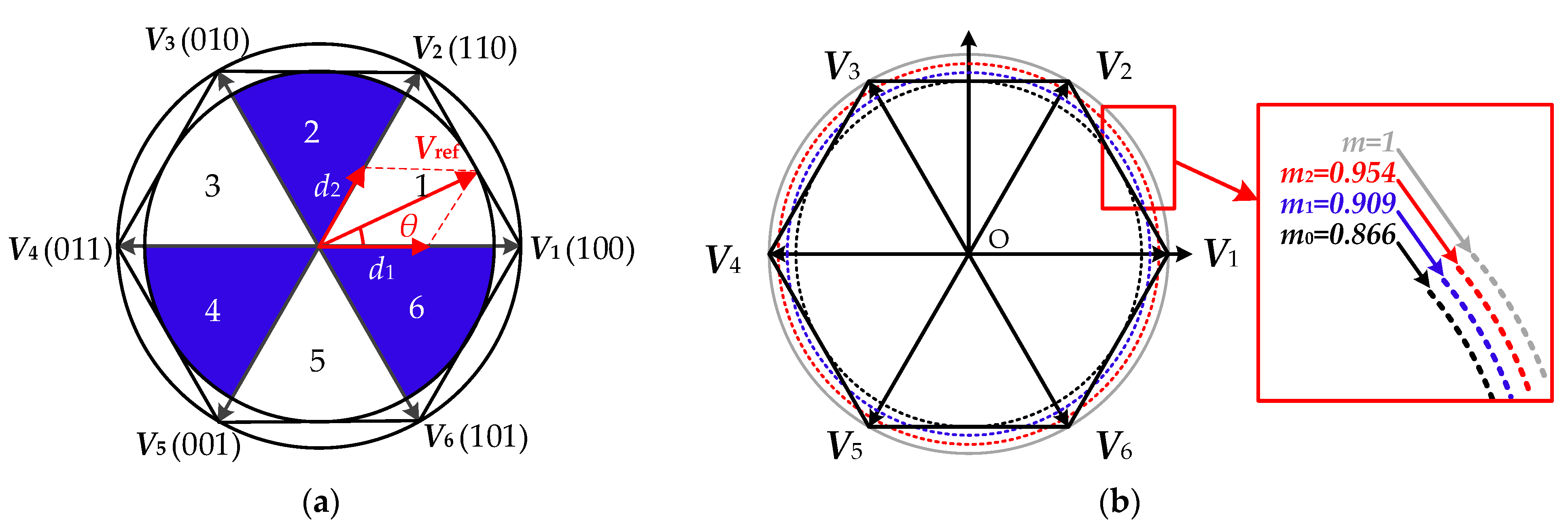
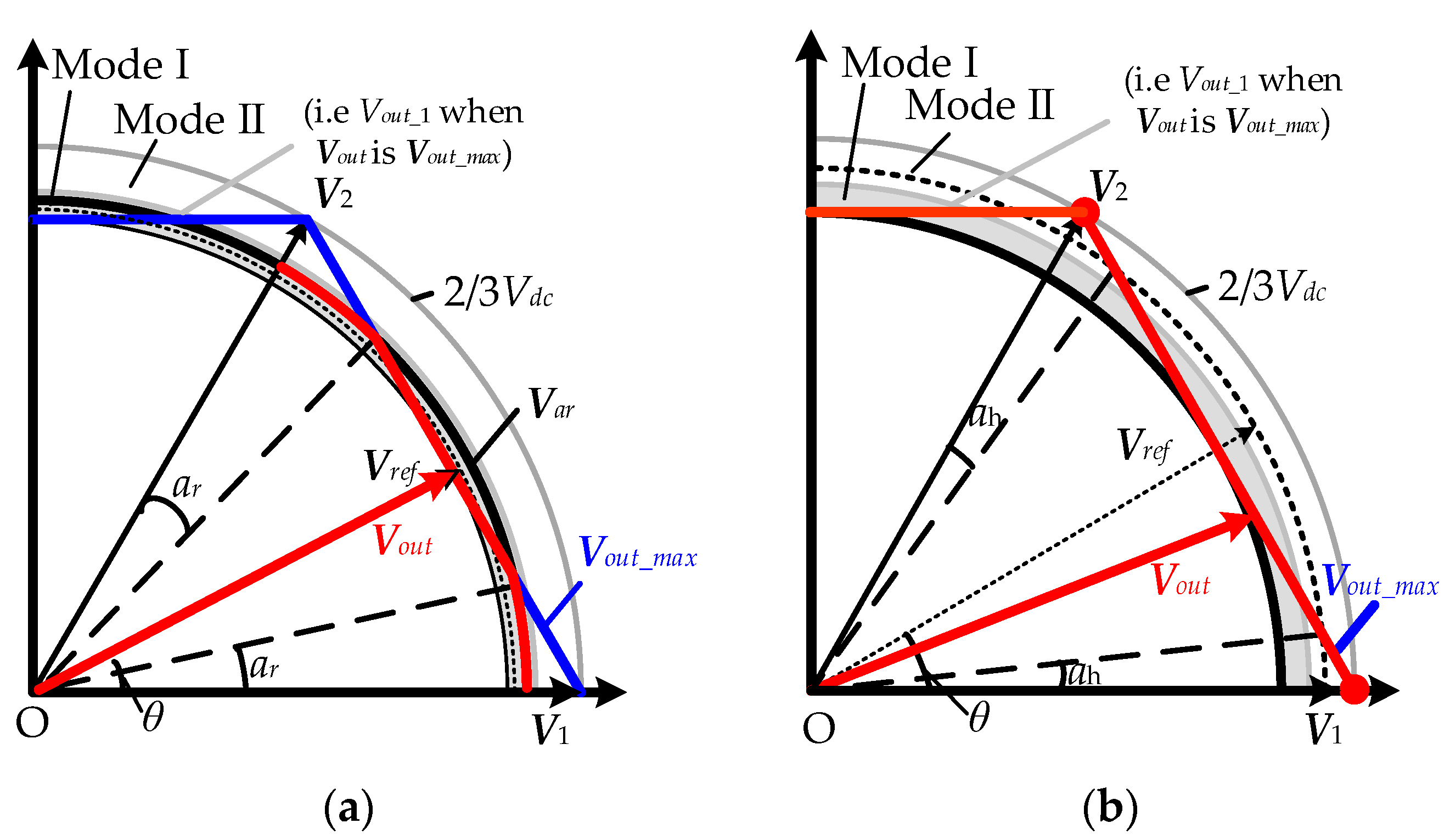
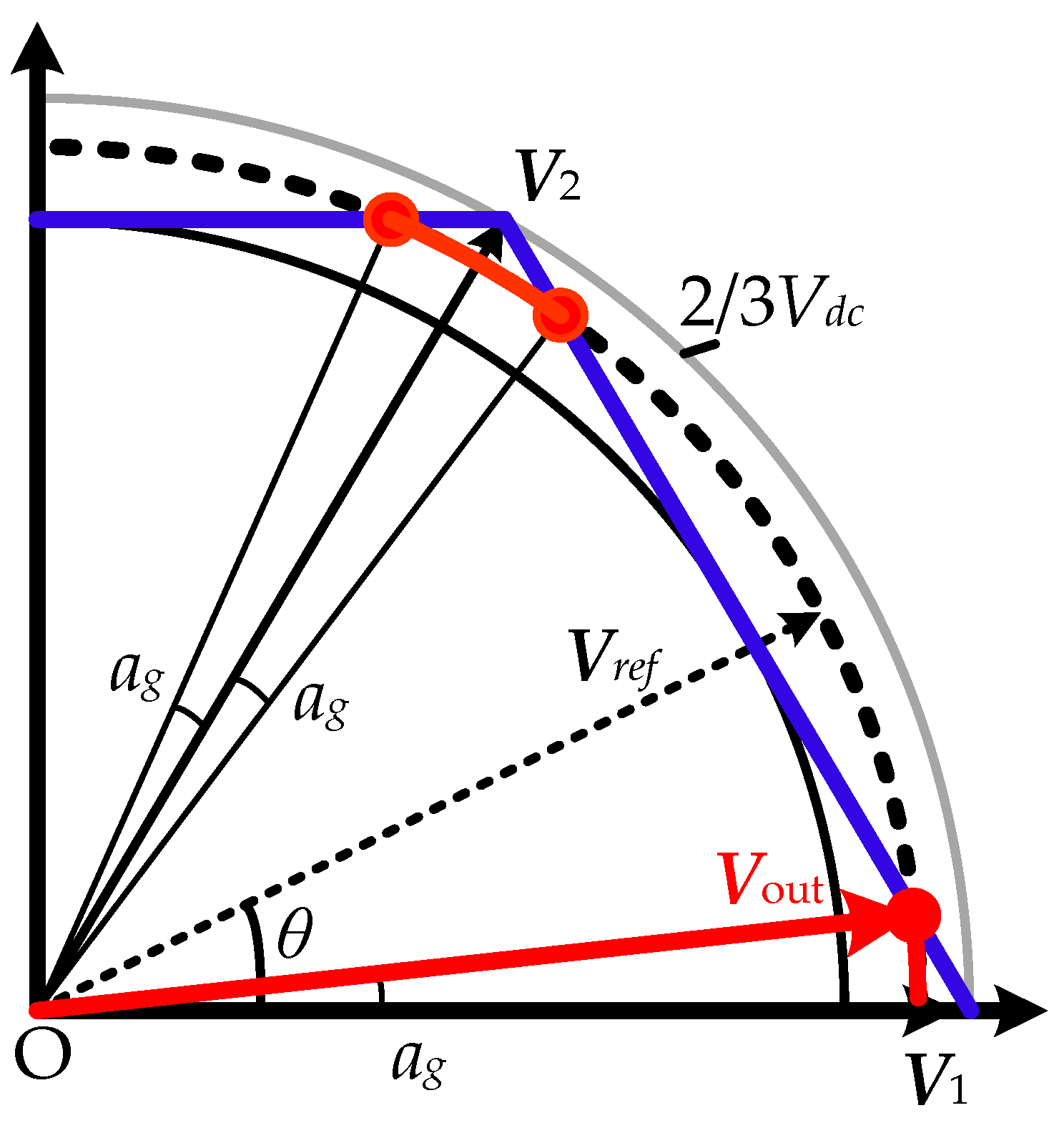
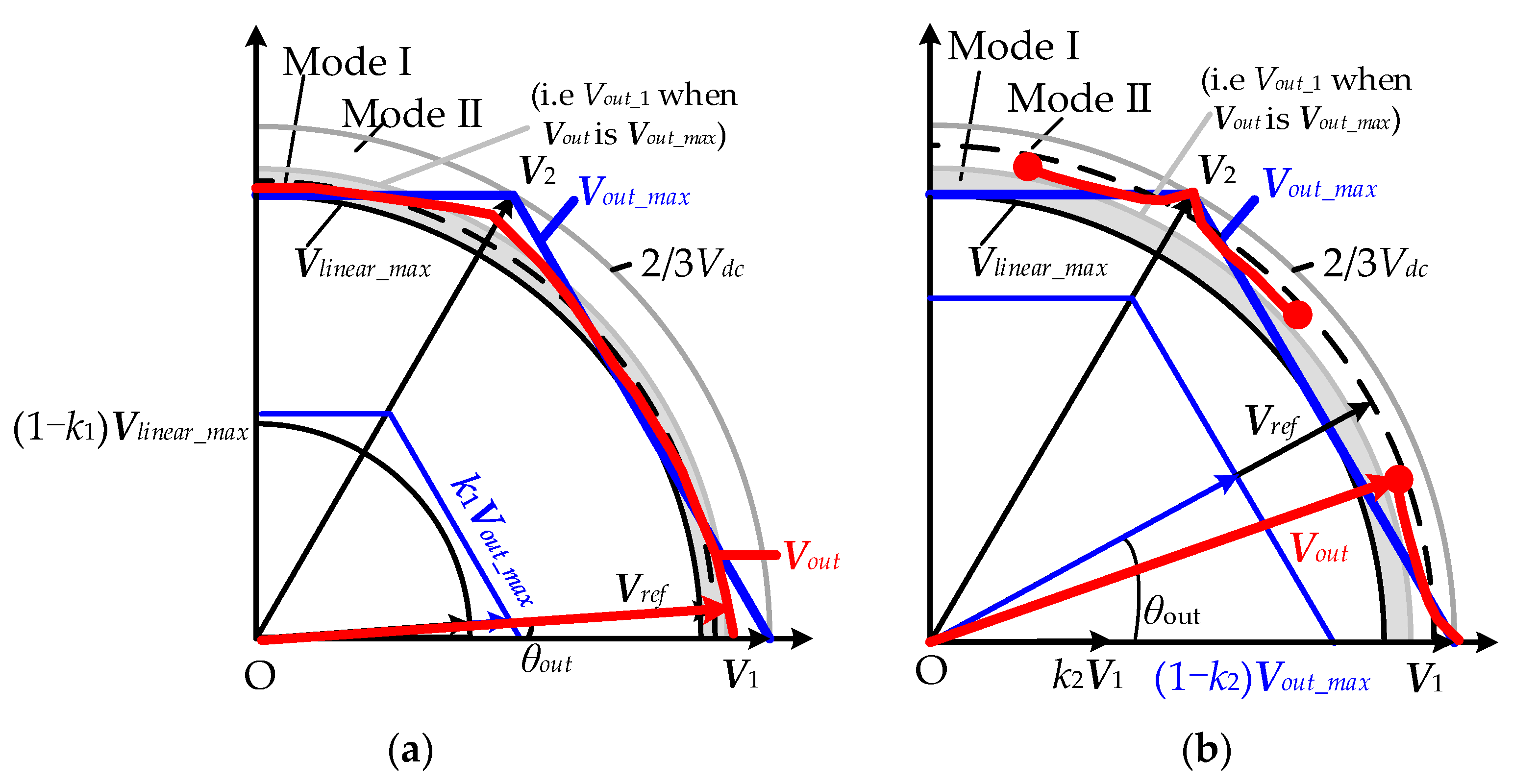
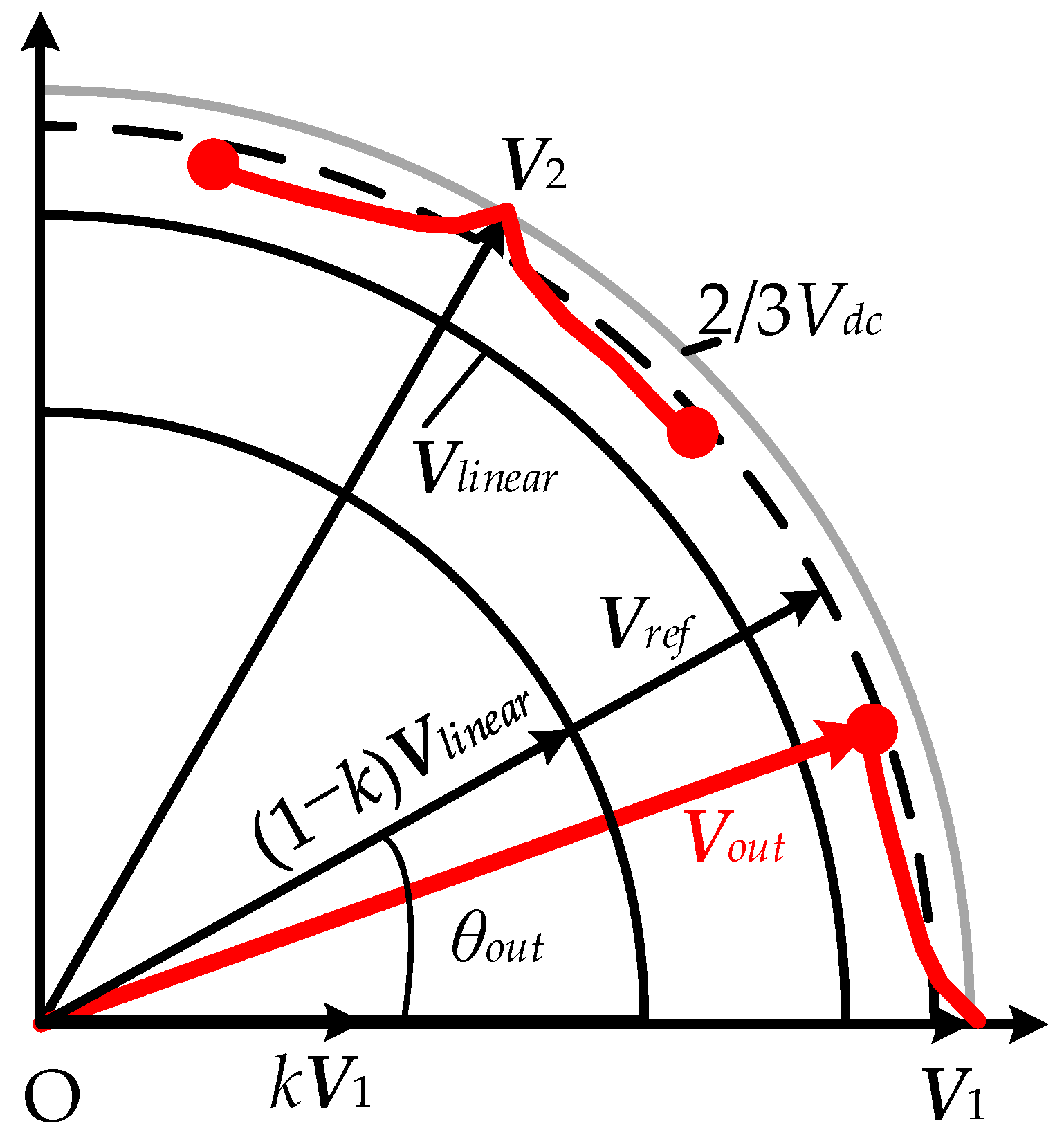


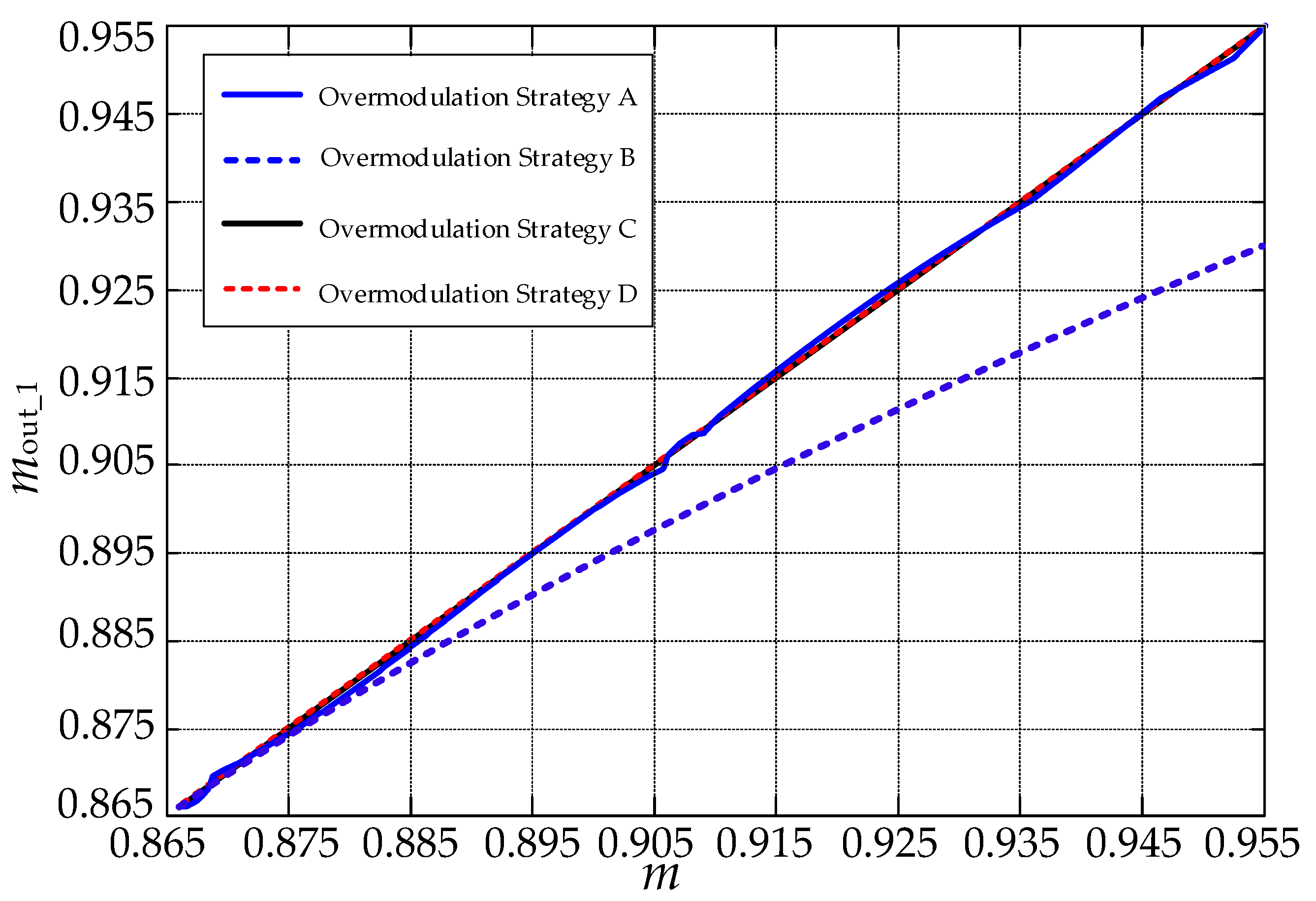

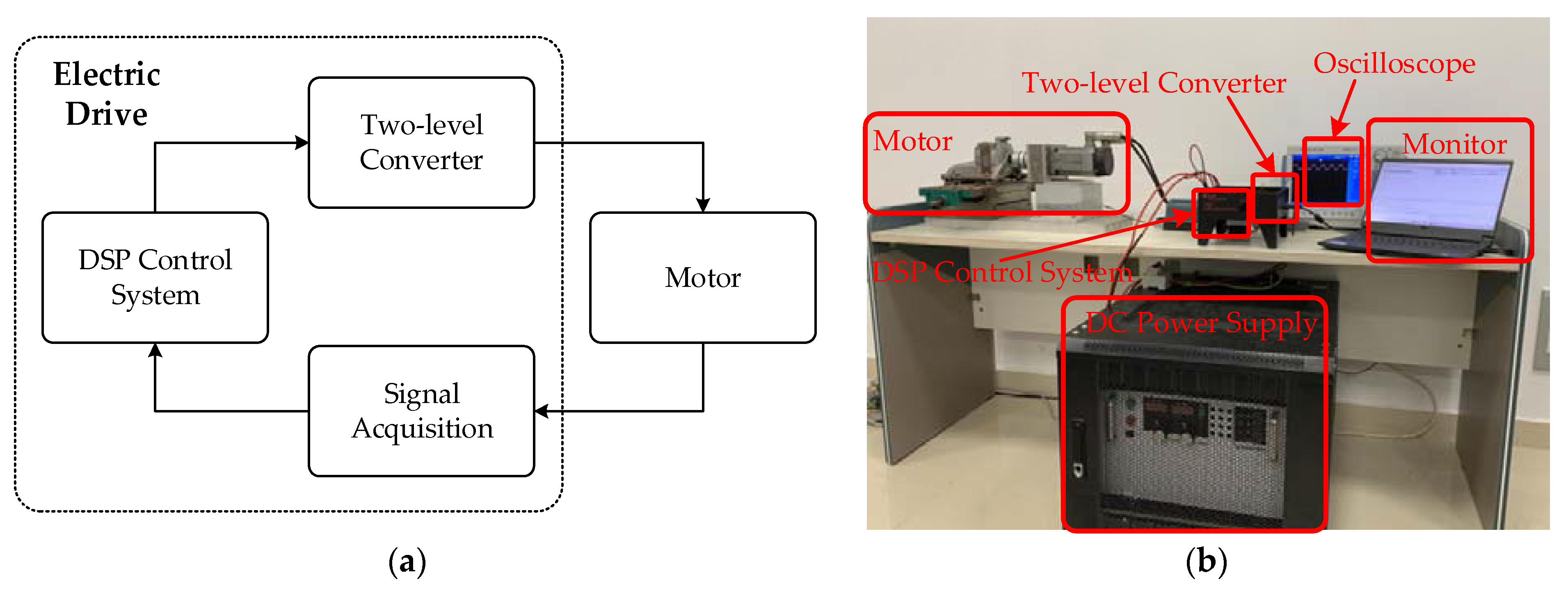
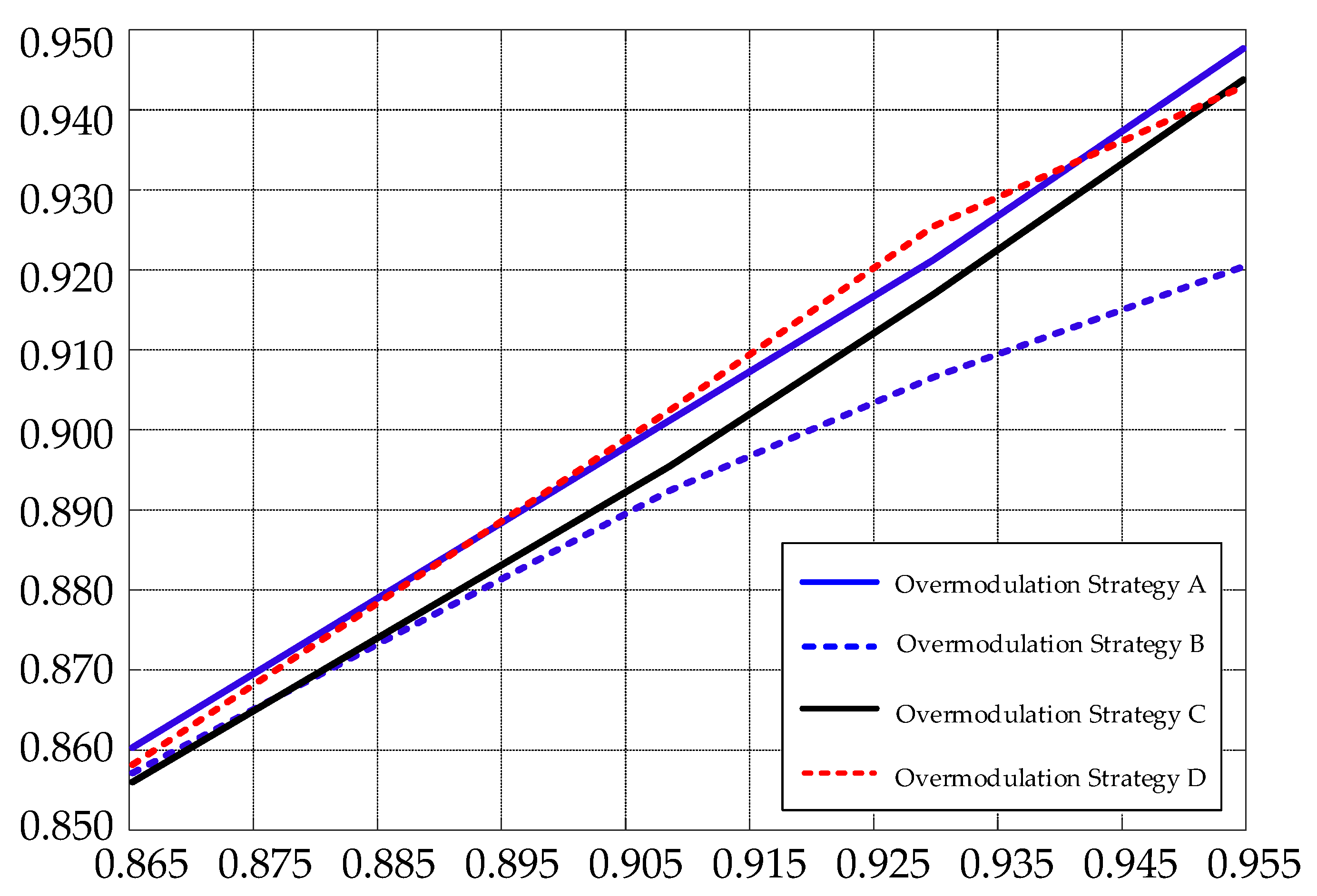



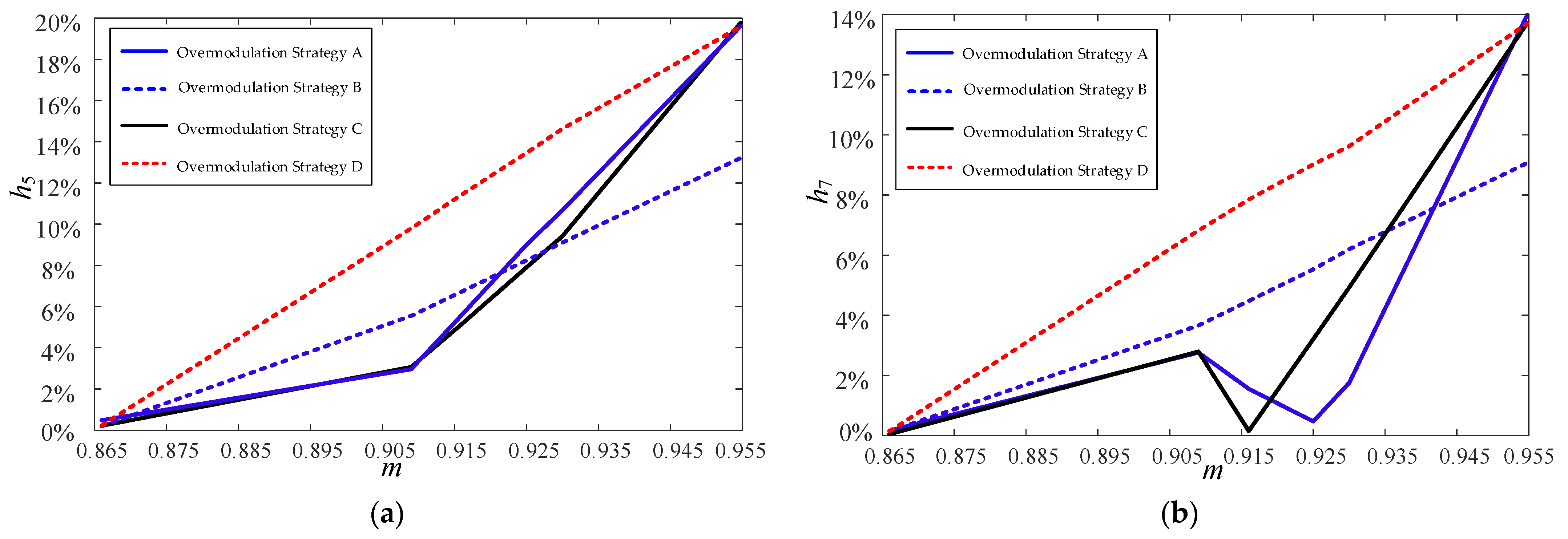

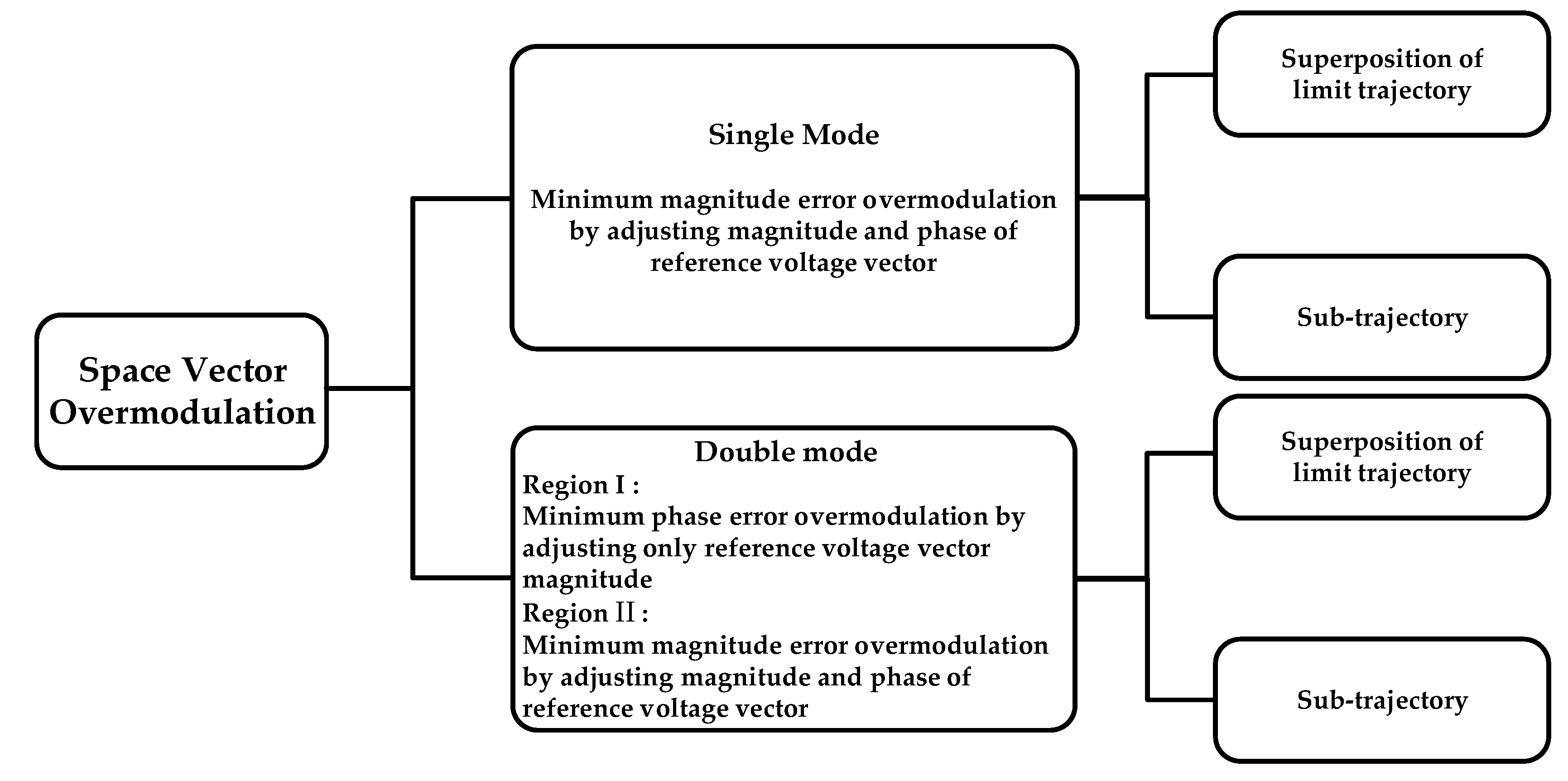
| Parameters | Value |
|---|---|
| DC bus voltage (Vdc) | 100 V |
| Carrier frequency | 10 kHz |
| Output fundamental frequency | 60 Hz |
| Modulation Ratio | Strategy A | Strategy B | Strategy C | Strategy D |
|---|---|---|---|---|
| 0.8660 | 0.8612 | 0.8581 | 0.8570 | 0.8591 |
| 0.9000 | 0.8929 | 0.8826 | 0.8951 | 0.8940 |
| 0.9090 | 0.9012 | 0.8926 | 0.8956 | 0.9024 |
| 0.9300 | 0.9207 | 0.9064 | 0.9165 | 0.9248 |
| 0.9548 | 0.9465 | 0.9199 | 0.9427 | 0.9419 |
| 0.9548 | 0.9465 | 0.9199 | 0.9427 | 0.9419 |
Publisher’s Note: MDPI stays neutral with regard to jurisdictional claims in published maps and institutional affiliations. |
© 2022 by the authors. Licensee MDPI, Basel, Switzerland. This article is an open access article distributed under the terms and conditions of the Creative Commons Attribution (CC BY) license (https://creativecommons.org/licenses/by/4.0/).
Share and Cite
Zhou, J.; Li, S.; Zhang, J.; Fang, T.; Zhang, X. Research on Space Vector Overmodulation Technology of Two-Level PWM Converters. Energies 2022, 15, 7086. https://doi.org/10.3390/en15197086
Zhou J, Li S, Zhang J, Fang T, Zhang X. Research on Space Vector Overmodulation Technology of Two-Level PWM Converters. Energies. 2022; 15(19):7086. https://doi.org/10.3390/en15197086
Chicago/Turabian StyleZhou, Jin, Shanhu Li, Jianning Zhang, Tianrui Fang, and Xiuyun Zhang. 2022. "Research on Space Vector Overmodulation Technology of Two-Level PWM Converters" Energies 15, no. 19: 7086. https://doi.org/10.3390/en15197086
APA StyleZhou, J., Li, S., Zhang, J., Fang, T., & Zhang, X. (2022). Research on Space Vector Overmodulation Technology of Two-Level PWM Converters. Energies, 15(19), 7086. https://doi.org/10.3390/en15197086







